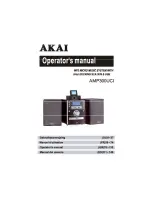
3
Multi-channel Wireless System
GENERAL TECHNICAL DESCRIPTION
The QUAD195 consists of two sub-systems; the housing which contains the gel-cell power supply and the RF/power
distribution module/s.
The housing is constructed of machined aluminum. A strap handle is bolted directly to the top panel of the housing
for ease of carrying. The lead-acid gel-cell batteries are connected in series to provide 12 VDC (nominal) power to all
the modules installed into the system. These batteries were selected for their recharge characteristics and reliability
under extreme conditions. The batteries are also highly resistant to damage caused by prolonged deep discharge.
The RF distribution circuitry includes helical resonators in the front end of the RF section to attenuate out-of-band RF
signals and prevent intermodulation and front end overload. Following the resonators is a low noise, low gain RF am
plifier designed to evenly compensate for splitter losses in the stage that follows. A precision splitter/isolator divides
the RF signal into four isolated signals, which prevents spurious RF coupling between receivers. The splitter/isola
tor is also termination independent, which prevents mismatched or disconnected RF outputs from affecting the other
receivers.
Power can be supplied to the distribution module from four possible sources. The primary source is the gel-cell bat
tery pack built into the bottom of the housing. Secondly, power may also be provided through an external DC power
source of 12 to 20 VDC of either polarity. When an external source is connected, an internal relay automatically
disconnects the internal battery pack. If that DC source fails or is disconnected, the system automatically reverts to
the internal batteries. AC power can be provided through the charger included with the unit. While operating in the
AC mode, the internal batteries are also recharged. The individual receivers and the distribution module can also be
operated from internal 9V alkaline batteries housed inside each unit’s battery compartment. In this mode of operation,
all receivers and the distribution module/s must to be manually switched for “internal” power on the control panel of
each unti. All power circuits in the distirbution module are independently protected by internal auto-reset fuses. If the
power to one receiver fails, the other receivers will continue to operate.
CDM4
smt
Block Diagram
AUTO
SWITCHING
RELAY
MAIN
CONTROL
SWITCH
BUILT-IN
RECHARGEABLE
BATTERIES
THERMAL
FUSES
SPLITTER
&
ISOLATOR
RF
AMP
FRONT-END
HELICAL
RESONATORS
9V BATT
THERMAL
FUSE
CHARGING
CIRCUIT
ANTENNA
EXTERNAL
12V DC
CH-50
110/115V AC
RF
TO RECEIVERS
12V DC
POWER TO
RECEIVERS
FRONT PANEL DESCRIPTION
Rio Rancho, NM – USA




























